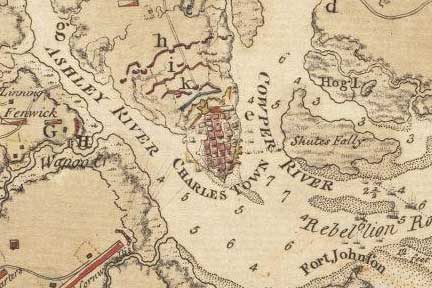Siege of Charleston 1779-1780

The British began a southern strategy by beginning a siege of Charleston. The siege lasted until May 9th when British artillery fire was close enough to set the town on fire and force a surrender.
.
By the end of 1778, the British came to the conclusion that they needed to break the stalemate that had developed in the war. A growing group of British strategists had been advocating for England to embark on a Southern strategy. It was believed the South had more loyalists, and thus, it would be a greater possibility to break the back of the rebellion by attacking the South. General Clinton, the British commander at the time, had resisted this strategy. However, he came to be convinced that it might work, and organized a campaign accordingly.
At the beginning of January, a British fleet departed New York with 9,000 soldiers aboard. The Americans were not sure where the British were going. Most indications were that they were heading South. The American Southern command was led by General Lincoln. When it became clear the British target was going to be Charleston, South Carolina, the call went out for American reinforcements. Whether militia forces or soldiers from the Continental Army, few reinforcements actually materialized.
On February 11th 1779, British troops arrived at Simmons Island, 20 miles below Charleston, after a difficult sea journey. It took the British a month to move to Charleston. Once there, Clinton decided that the city's defenses were formidable. Clinton concluded that the best plan would be to surround the city and conduct a European style investment. The American Commander, General Lincoln, on the other hand, did not follow Washington’s example of moving out of a city in face of superior British forces. Instead, under pressure from municipal leaders, Lincoln stayed in the city to defend it. The British slowly tightened their noose around Charleston.
On March 20th, the British were able to bring a fleet of ships into the harbor opposite the city. British entered the harbor, despite General Lincoln's hopes, that the harbor's sand bar would allow him to successfully defend the city against the British.
The Americans lost a major engagement at Moncks corner. Before long, British lines surrounded the city and advanced within 250 feet of American lines. Clinton ordered a bombardment of Charleston. The result was that 510 soldiers a day were either killed or wounded.
The situation in Charleston was becoming untenable. On April 21st, Lincoln sent draft terms for surrender to Clinton, demanding that all American forces be allowed to withdraw. Clinton refused the offer to surrender and the bombardment intensified. On May 9th, Lincoln once again presented more limited terms for surrender. General Clinton, who was eager to end the campaign accepted. However, Clinton demanded that the American troops who would be allowed to leave would be considered prisoners of war, until being paroled- thus, not allowing them to serve in the meantime. Lincoln refused that condition and the bombardment continued.
Two days later, Lincoln was forced to agree to an unconditional surrender, after the British threatened terrible retribution on the inhabitants of the city, if the Americans did not choose to surrender. During the long siege the Americans had lost 225 men, while the British lost 265 soldiers. 5,700 American soldiers and 1,000 sailors fell into British captivity. This was the largest loss of the war. Considering the fact that over 45% of the American prisoners of war died during captivity, the surrender had terrible personal consequences for those captured- (the enlisted men). The officers were paroled.
Following the capture of Charleston, North Carolina, Clinton assigned General Cornwallis to pacify the countryside and destroy any remaining American military. In one of the most notorious encounters of the war, the British cavalrymen, under the command of Colonel Tarleton, caught up with a force of Virginian Continentals who were retreating back to North Carolina. The British troops overwhelmed the larger American force, but then went on to massacre the surrendering American forces.
 >
>